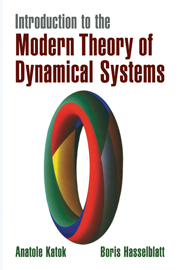Book contents
- Frontmatter
- Contents
- PREFACE
- 0 INTRODUCTION
- Part 1 Examples and fundamental concepts
- Part 2 Local analysis and orbit growth
- 6 LOCAL HYPERBOLIC THEORY AND ITS APPLICATIONS
- 7 TRANSVERSALITY AND GENERICITY
- 8 ORBIT GROWTH ARISING FROM TOPOLOGY
- 9 VARIATIONAL ASPECTS OF DYNAMICS
- Part 3 Low-dimensional phenomena
- Part 4 Hyperbolic dynamical systems
- Appendix: BACKGROUND MATERIAL
- NOTES
- HINTS AND ANSWERS TO THE EXERCISES
- REFERENCES
- INDEX
8 - ORBIT GROWTH ARISING FROM TOPOLOGY
Published online by Cambridge University Press: 05 June 2012
- Frontmatter
- Contents
- PREFACE
- 0 INTRODUCTION
- Part 1 Examples and fundamental concepts
- Part 2 Local analysis and orbit growth
- 6 LOCAL HYPERBOLIC THEORY AND ITS APPLICATIONS
- 7 TRANSVERSALITY AND GENERICITY
- 8 ORBIT GROWTH ARISING FROM TOPOLOGY
- 9 VARIATIONAL ASPECTS OF DYNAMICS
- Part 3 Low-dimensional phenomena
- Part 4 Hyperbolic dynamical systems
- Appendix: BACKGROUND MATERIAL
- NOTES
- HINTS AND ANSWERS TO THE EXERCISES
- REFERENCES
- INDEX
Summary
In Section 3.1 we described several invariants related to the asymptotic growth of the complexity of the orbit structure. The most direct information of that kind is provided by the growth of periodic orbits (3.1.1) and topological entropy (Definition 3.1.3), which reflects the growth of the number of orbits distinguishable with limited precision. On the other hand we defined the fundamental-group entropy (3.1.23) and the spectral radii of the action on homology (Section 3.1e) which less directly reflect the growth in topological complexity of families of orbits from the homotopical and homological point of view. An obvious advantage of the latter invariants is that in general they can be calculated more easily since they are invariant under homotopy equivalence. For example, since every map of the torus is homotopically equivalent to a linear map (see Sections 2.6 and 8.7 for details), it suffices to consider linear maps when calculating the fundamental-group entropy and the spectral radii of the action on homology. In this chapter we will show how these homotopical and homological invariants provide information related to growth of orbits, that is, we will find quantitative relationships between growth (and in particular existence) of periodic orbits and topological entropy on the one hand, and these topological data on the other.
- Type
- Chapter
- Information
- Introduction to the Modern Theory of Dynamical Systems , pp. 307 - 334Publisher: Cambridge University PressPrint publication year: 1995

